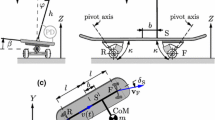Abstract
The movement of a skier in the process of acceleration down a straight track is considered. It is proposed to picture the skier as a bunch of two solid bodies linked to each other at a certain angle, one of which (“wing”) has an aerodynamic quality. The choice of the desired mode of descent occurs due to the control moment applied at the point of contact of the body with the surface, and due to the choice of the mounting angle. The main attention is paid to the consideration of the question of the movement of this bunch of bodies, provided that the “skier’s stance” does not change during the descent. It is shown that there is a certain value of the setting angle of the “wing”, at which the maximum value of the descent speed is reached at any moment of time. This extreme value of the angle depends only on the aerodynamic characteristics of the force. Thus, it has been established that within the framework of the proposed mathematical model, in order to achieve the maximum possible descent speed, it is necessary to maintain a constant stance and body shape. The implementation of this extreme descent mode is limited only by the ability to provide the required control moment. It is shown that under certain conditions the reaction force is nullified, the body is separated from the surface, and with a continuing increase in speed. It has been established that after such a separation, there is no return to the surface; in the future, the body makes a free flight with access to the stable gliding mode.








Similar content being viewed by others
REFERENCES
A. R. Podgayets and R. N. Rudakov, “Biomechanical problems of a ski jump,” Russ. J. Biomech. 4 (2), 1–11 (2000).
L. P. Remizov, “Optimal running on skis in downhill,” J. Biomech. 13 (11), 941–945 (1980).
R. Maronski, “On optimal running downhill on skis,” J. Biomech. 23 (5), 435–439 (1990).
B. Ya. Lokshin and V. A. Samsonov, The Problem of the Motion of a Body in a Resisting Medium. Qualitative Analysis (Mosk. Univ., Moscow, 2012) [in Russian].
B. Ya. Lokshin and V.A. Samsonov, “Features of movement of a rotational body,” Mech. Solids 53, 51–59 (2018). https://doi.org/10.3103/S0025654418010065
A. V. Voronov and D. R. Hisnutdinova, “Theoretical and experimental evaluation of shin triceps muscle heads during extension of ankle joint,” Vestn. Sport. Nauki, No. 4, 44–55 (2011).
Author information
Authors and Affiliations
Corresponding authors
Additional information
Translated by Katuev M.K.
About this article
Cite this article
Lokshin, B.Y., Samsonov, V.A. ON THE DESCENT OF A SKIER DOWN A STRAIGHT TRACK. Mech. Solids 57, 804–819 (2022). https://doi.org/10.3103/S0025654422040124
Received:
Revised:
Accepted:
Published:
Issue Date:
DOI: https://doi.org/10.3103/S0025654422040124




